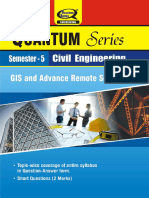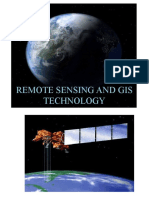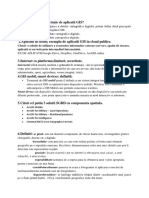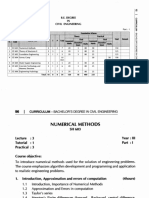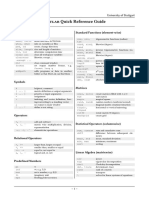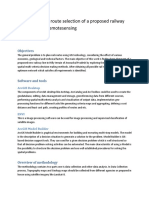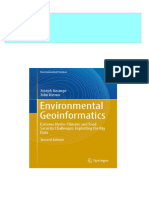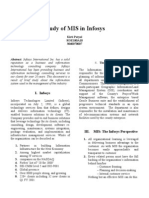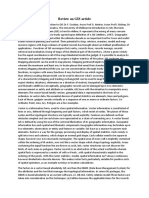Post Graduate Professional Diploma in Geoinformatics PDF
Post Graduate Professional Diploma in Geoinformatics PDF
Uploaded by
Diwas PoudelCopyright:
Available Formats
Post Graduate Professional Diploma in Geoinformatics PDF
Post Graduate Professional Diploma in Geoinformatics PDF
Uploaded by
Diwas PoudelOriginal Title
Copyright
Available Formats
Share this document
Did you find this document useful?
Is this content inappropriate?
Copyright:
Available Formats
Post Graduate Professional Diploma in Geoinformatics PDF
Post Graduate Professional Diploma in Geoinformatics PDF
Uploaded by
Diwas PoudelCopyright:
Available Formats
POST GRADUATE PROFESSIONAL DIPLOMA IN GEOINFORMATICS
Now emerging technologies like GIS and RS, Photogrammetry helps in effectively managing
world around us and touching all aspect of life. Geo-informatics is a fast growing industry
worldwide. A practical knowledge is very crucial in order to understand the concept deeply to
explore the innovative use of the technology and its application areas.
Why choose this course?
This is a platform where we can help you to fill the gap between academics and industry by
providing quality training as per the industry requirements which results in “Ready for Industry”
skilled and trained professionals.
Technologies Covered
We have seven technologies which you can learn different modes of study accordingly:
One year program in regular weekdays
You will learn:
Geographical Information System
Remote sensing
Digital Photogrammetry
Digital Image Processing
Modern Surveying Technology
LIDAR
DRONE/UAV
Course duration:
Nine months technical training and 3 months live project training.
One year program in regular weekends
You will learn:
Geographical Information System
Remote sensing
Digital Photogrammetry
Digital Image Processing
Modern Surveying Technology
LIDAR
DRONE/UAV
Course duration:
Nine months technical training and 3 months live project training.
One year program in online weekends
You will learn:
Geographical Information System
Remote sensing
Digital Image Processing
Modern Surveying Technology
LIDAR
Course duration:
12 months training
Minimum eligibility
Graduation/ (10+2+3) or higher degree.
Engineering (IT, Computer Science, Civil Engineering).
Geography, Geology, Disaster management, Agriculture management.
Table of Contents
1. GIS: Learn GIS to make maps and perform various analysis on Spatial data.
Introduction and objectives of GIS
Concept of Geospatial data
GIS data Sources
GIS data models
Geo-referencing
Projection and scaling
Making GIS layers in different platforms
Digitization (Point, Line, Polygon)
GIS data conversion / Importing and exporting of data from one to another platforms
Data collection for GIS base Mapping
GIS data linking (Spatial and Non-spatial)
Topology building
Query building
Map Composition (Thematic Mapping)
Base Map generation techniques for surveying
Land use and Land cover Mapping
Making Digital database /Making Geodata Base of Land Records
Analysis for GIS (Buffer, Overlay, Watershed, Network)
Applications of GIS layers
2. Remote Sensing: Learn Remote Sensing to know about and acquire the satellite Imageries.
Introduction and objectives of RS
Electromagnetic Spectrum
Interaction with earth surface
Spectral signature
Platforms: ground base, air borne, space borne
Sun-synchronous and geostationary satellites
Indian Remote Sensing Satellites
Satellite data types: FCC and PAN images
Satellite Image study in Different bands
Stacking of different bands of Image
Subset, mosaic of satellite imagery
Multi spectral concept of image interpretation
Application of remote sensing in various fields
3. Digital Image Processing: Learn DIP to edit the satellite Imageries in order to make a better
interpretable one. By applying classification on Images, one can calculate the area for various
classes.
Introduction and objectives of DIP
Concept of Digital Image
Digital data formats
Data conversion
GCP collection
Image corrections (geometric, radiometric and atmospheric)
Image enhancement techniques (Filtering, stretching, smoothing)
PCA, TCA Analysis
Resolution merge
Spectral signatures
Classification techniques and algorithm
Recoding
Accuracy assessment
Land use land cover
Change detection
Application in agriculture, forest etc.
4. GPS:
Introduction of Global Positioning System
Satellite constellation
GPS signals
GPS data
DGPS techniques
Concept of NAVSTAR,GLONASS, GALILEO system
Geodesy
Geoid/datum/Ellipsoid
Coordinate system
Map Scale, Scale factors
Map projections
GPS segments
GPS data collection of point, line, Polygon features
GPS errors and accuracy
DOP(Dilution of Precision)
Satellite signals and its strength
GPS Applications in various field
Future of GPS
5. LiDAR:
Basic concept of LiDAR Technology
Principle of LiDAR Technology
Types of LiDAR data
Basic architecture of LiDAR technology
LiDAR System Specification
Data Storage
Software for Quality Assessment
Introduction and objectives of LiDAR data processing
Products of LiDAR application
Contour generation
Source of Errors in LiDAR data
Application of LiDAR for mapping and planning, volumetric analysis, power sector,
smart city, topographical study
6. Photogrammetry:
Fundamental concept and basic information and specification of Aerial photography.
Introduction and objectives of Aerial camera, Metric camera
Camera calibration for Aerial Photography, Aerial film and types of Aerial camera lenses
and lens distortion
Geometry, Projection and properties of Aerial Photographs,
Overlapping on Aerial Photographs and their types,
Photogrammetric workflow
Photogrammetric platforms
Interpretation Elements of Air Photo
Accuracy, Error, Precision
Introduction and objectives of Stereo Photogrammetry
Aerial triangulation
Generating geospatial datasets
DEM and orthophoto’s generation
Concept of Mass points and Break lines
Contours and their types Volumetric Analysis.
Concept of DEM, DTM, TIN, GRID and DSM.
Aerial Photo mosaic
Photogrammetric product and its application.
Applications of Photogrammetric products for mapping and planning
7. Drone:
Fundamental
Components
Working principle
Types
Drone Camera
Flight planning
You might also like
- GIS - Advanced Remote SensingDocument134 pagesGIS - Advanced Remote SensingSatyam Lakhera100% (1)
- Direct Georeferencing 3D Points Cloud Map Based On SLAM and Robot Operating SystemDocument5 pagesDirect Georeferencing 3D Points Cloud Map Based On SLAM and Robot Operating SystemFraj HarizNo ratings yet
- GIS Past Paper ExamsDocument11 pagesGIS Past Paper ExamsShoturu100% (8)
- Mining Syllabus, B.I.T SindriDocument38 pagesMining Syllabus, B.I.T Sindriazad15_90No ratings yet
- Three Months Certificate CourseDocument5 pagesThree Months Certificate CourseDiwas PoudelNo ratings yet
- One Month Certified CoursesDocument4 pagesOne Month Certified CoursesDiwas PoudelNo ratings yet
- Master Drone Surveying Data Capture, Processing & DGPS brochureDocument6 pagesMaster Drone Surveying Data Capture, Processing & DGPS brochureayushsolanki035No ratings yet
- RS&GISDocument2 pagesRS&GISramupallagani0No ratings yet
- GIS - Advanced Remote SensingDocument133 pagesGIS - Advanced Remote SensingAaNo ratings yet
- Cle2023 Gis-And-Remote-Sensing Eth 1.0 37 Cle2023 15Document2 pagesCle2023 Gis-And-Remote-Sensing Eth 1.0 37 Cle2023 15Ashish SinhaNo ratings yet
- What Is GIS?Document6 pagesWhat Is GIS?Arathi NittadukkamNo ratings yet
- EVALUATION OF ACCURACY GPS AND AUTOMATIC LEVEL INSTRUMENTS IN TOPOGRAPHIC SURVEYINGDocument5 pagesEVALUATION OF ACCURACY GPS AND AUTOMATIC LEVEL INSTRUMENTS IN TOPOGRAPHIC SURVEYINGMohammed KareemNo ratings yet
- Afrah SafaDocument11 pagesAfrah Safamariam qaherNo ratings yet
- Geoinformatics For Infrastructure ManagementDocument2 pagesGeoinformatics For Infrastructure ManagementSreejith Rajendran PillaiNo ratings yet
- Sensor Integration For Improved Surface ModelingDocument4 pagesSensor Integration For Improved Surface ModelingalihahgfdNo ratings yet
- Complete CSIT M.tech (GST) Syllabus 2012Document30 pagesComplete CSIT M.tech (GST) Syllabus 2012شاطئ النسيانNo ratings yet
- MH4221 Geographical Information Systems For Built EnvironmentDocument2 pagesMH4221 Geographical Information Systems For Built Environmentanbarasan0No ratings yet
- AGF - Lidar For GCP Determination in Topographic Mapping Scale 1:50.000Document13 pagesAGF - Lidar For GCP Determination in Topographic Mapping Scale 1:50.000Aji Putra Perdana100% (1)
- Automated Land Classification Using AIMLDocument3 pagesAutomated Land Classification Using AIMLInternational Journal of Innovative Science and Research TechnologyNo ratings yet
- Principles of Cartography 362: Map Compilation and Cartographic Map DesignDocument42 pagesPrinciples of Cartography 362: Map Compilation and Cartographic Map DesignAthirah Illaina50% (2)
- 1 - Introduction To GISDocument27 pages1 - Introduction To GISpunjabihtsNo ratings yet
- ts17 03 ElsheimyDocument24 pagests17 03 ElsheimyEmerson GranzottiNo ratings yet
- Combining Airborne Oblique Camera and Lidar Sensors: Investigation and New PerspectivesDocument8 pagesCombining Airborne Oblique Camera and Lidar Sensors: Investigation and New PerspectivesRicardo Saavedra CotrinaNo ratings yet
- Unit-1 Geographic Information SystemDocument25 pagesUnit-1 Geographic Information Systemreqmail2023No ratings yet
- Resume 202410231251Document1 pageResume 202410231251Tridib KumarNo ratings yet
- Performance of Quickbird Image and Lidar Data Fusion For 2d/3d City MappingDocument13 pagesPerformance of Quickbird Image and Lidar Data Fusion For 2d/3d City MappingTony BuNo ratings yet
- Isprs Annals IV 2 255 2018Document8 pagesIsprs Annals IV 2 255 2018Netra Bahadur KatuwalNo ratings yet
- sample pptDocument17 pagessample pptshashwatdhiman.bt23civNo ratings yet
- Data Input and EditingDocument47 pagesData Input and Editingvarunsingh2147610% (1)
- Dem Erdas ImagineDocument11 pagesDem Erdas ImagineMohannad S ZebariNo ratings yet
- RS GIS 18CV651 Notes MODULE 1Document13 pagesRS GIS 18CV651 Notes MODULE 1Brundaja D NNo ratings yet
- Remote Sensing and Gis TechnologyDocument13 pagesRemote Sensing and Gis Technologykukkur007No ratings yet
- GisDocument84 pagesGisMinalNo ratings yet
- Remote Sensing & GIS PracticalDocument90 pagesRemote Sensing & GIS Practicalchahat.2021.660No ratings yet
- 3D Mapping of Selected Regions Using NavIC ReceiversDocument12 pages3D Mapping of Selected Regions Using NavIC ReceiversInternational Journal of Innovative Science and Research Technology100% (1)
- GIS Data Capture:: Getting The Map Into The ComputerDocument18 pagesGIS Data Capture:: Getting The Map Into The ComputerridhuanNo ratings yet
- Revised Syllabus For GisDocument4 pagesRevised Syllabus For GisMantu RnNo ratings yet
- Collage of Computing and Informatics: Department of Information SystemsDocument13 pagesCollage of Computing and Informatics: Department of Information SystemsFiroomsaa UshuNo ratings yet
- Chap 2 Geospatial Data Collection and Use Cases in RwandaDocument6 pagesChap 2 Geospatial Data Collection and Use Cases in RwandaBizimenyera Zenza TheonesteNo ratings yet
- Pages From Final - Year-2Document1 pagePages From Final - Year-2shammi007No ratings yet
- UE 461 Intro. To GIS - 12Document124 pagesUE 461 Intro. To GIS - 12Ambachew AlitahNo ratings yet
- NRSC-RMT-1-2024 Post Code 16 SyllabusDocument3 pagesNRSC-RMT-1-2024 Post Code 16 SyllabusRahil TeliNo ratings yet
- Ce 531, GisDocument38 pagesCe 531, Gissagardatta2467No ratings yet
- New TridibDocument1 pageNew TridibTridib KumarNo ratings yet
- RS GisDocument2 pagesRS Gisvaibhav.kolla22No ratings yet
- 3D Modeling and Terrain Analysis 2024Document14 pages3D Modeling and Terrain Analysis 2024Sk Najib HossainNo ratings yet
- Digital Elevation Models ReportDocument9 pagesDigital Elevation Models ReportScribdTranslationsNo ratings yet
- PDF Scurt BdsDocument4 pagesPDF Scurt BdsBogdan Marian BaburuNo ratings yet
- Gis Chapter1 2011 IntroductionDocument48 pagesGis Chapter1 2011 Introductionsnehal_prasadNo ratings yet
- GIS & RS Book (Final)Document122 pagesGIS & RS Book (Final)doc. safe eeNo ratings yet
- Digital Elevation Modeling IsDocument34 pagesDigital Elevation Modeling IsArindam RoulNo ratings yet
- Geographical Information System: Course DescriptionDocument4 pagesGeographical Information System: Course DescriptionRaito KriesNo ratings yet
- Bilal assighnment survying 2Document7 pagesBilal assighnment survying 2mianbilal4848No ratings yet
- IGNTU EContent 389370446684 BA GeographyandRegionalDevelopment 4 DR - Richachaturvedi IntroductiontoRemoteSensingandGIS Unit4Document15 pagesIGNTU EContent 389370446684 BA GeographyandRegionalDevelopment 4 DR - Richachaturvedi IntroductiontoRemoteSensingandGIS Unit4091 Santhosh MNo ratings yet
- Report On Remote SensingDocument6 pagesReport On Remote Sensingnandisujoy573No ratings yet
- Science or Geospatial Information Studies To Refer To The Academic Discipline or Career of Working WithDocument40 pagesScience or Geospatial Information Studies To Refer To The Academic Discipline or Career of Working WithAkarshsachin DesaiNo ratings yet
- Drone SurveyDocument4 pagesDrone Survey丨ㄒ丂ᐯ乇ᗪ卂几ㄒNo ratings yet
- Materi Kuliah GD 3204 Fotogrametri I, Semester II - 2011/2012Document34 pagesMateri Kuliah GD 3204 Fotogrametri I, Semester II - 2011/2012Farel Muhammad DItaNo ratings yet
- GeoinformaticsDocument19 pagesGeoinformaticsRazi BaigNo ratings yet
- Bce Iii I PDFDocument27 pagesBce Iii I PDFDiwas PoudelNo ratings yet
- Engineering Year:: Degree CDocument17 pagesEngineering Year:: Degree CDiwas PoudelNo ratings yet
- Matlab Quick Reference Guide: Institute of Geodesy University of StuttgartDocument2 pagesMatlab Quick Reference Guide: Institute of Geodesy University of StuttgartDiwas PoudelNo ratings yet
- MatrixAlgebra MatrixAnalysis LagrangeMultipliersDocument58 pagesMatrixAlgebra MatrixAnalysis LagrangeMultipliersDiwas PoudelNo ratings yet
- Methodology of Route Selection of A Proposed RailwayDocument10 pagesMethodology of Route Selection of A Proposed Railwaysoumya_cu100% (1)
- Global Information Systems: Hossein BIDGOLIDocument37 pagesGlobal Information Systems: Hossein BIDGOLIErmercadoNo ratings yet
- Gis HomeworkDocument8 pagesGis Homeworkg3mk6p0h100% (1)
- GIS in Social Science Workshop PresentationDocument19 pagesGIS in Social Science Workshop PresentationIr LeeNo ratings yet
- Gis Question BankDocument23 pagesGis Question BankVENKATESH100% (6)
- Full Environmental Geoinformatics Extreme Hydro Climatic and Food Security Challenges Exploiting The Big Data Joseph Awange Ebook All ChaptersDocument62 pagesFull Environmental Geoinformatics Extreme Hydro Climatic and Food Security Challenges Exploiting The Big Data Joseph Awange Ebook All Chaptersgenpeilyetu100% (4)
- Topoxpress Manual 2020Document74 pagesTopoxpress Manual 2020Rade RaonicNo ratings yet
- GIS Applications in LogisticsDocument3 pagesGIS Applications in LogisticsSiddhant.Bhalla Btech2019No ratings yet
- Study of MIS in InfosysDocument6 pagesStudy of MIS in Infosyskirti patial50% (6)
- Lec 1 - Intro To GISDocument53 pagesLec 1 - Intro To GISAlind mmNo ratings yet
- Technical Questions For Water Loss Audit Engineer InterviewDocument16 pagesTechnical Questions For Water Loss Audit Engineer Interviewmore.dipaNo ratings yet
- Makalah - TB2 Statistika Valdano EsnaidarDocument5 pagesMakalah - TB2 Statistika Valdano EsnaidarBagas Dwi HaztomoNo ratings yet
- Geographic Information System Literature ReviewDocument5 pagesGeographic Information System Literature Reviewafmyervganedba100% (1)
- Introduction To Geomatic EngineeringDocument64 pagesIntroduction To Geomatic EngineeringsachindassNo ratings yet
- IAS Compass - Current Affairs Compilation For Mains - Science TechDocument55 pagesIAS Compass - Current Affairs Compilation For Mains - Science Techkaliramanpriya2No ratings yet
- Metropolitan Archivist Volume 21, No. 1 (Winter 2015)Document17 pagesMetropolitan Archivist Volume 21, No. 1 (Winter 2015)Archivists Round Table of Metropolitan New York, Inc.No ratings yet
- Planning Walkable Neighborhoods - Are We Overlooking Diversity in Abilities and AgesDocument14 pagesPlanning Walkable Neighborhoods - Are We Overlooking Diversity in Abilities and AgesavvakirilovaNo ratings yet
- Thesis Submitted To HecDocument8 pagesThesis Submitted To Hecafknlbbnf100% (1)
- GIS Article ReviewDocument2 pagesGIS Article ReviewHalimah SheikhNo ratings yet
- 3 GIS Data StructureDocument31 pages3 GIS Data StructurePujhaFransismikSadegaNo ratings yet
- Gebresilasse (2020) - Rural Roads, Agricultural Extension, and Productivity PDFDocument62 pagesGebresilasse (2020) - Rural Roads, Agricultural Extension, and Productivity PDFDiana Pineda KerguelenNo ratings yet
- Baseline Survey For Street Dogs in Haryana State IndiaDocument25 pagesBaseline Survey For Street Dogs in Haryana State IndiaBhargav TrivediNo ratings yet
- WASSCE WAEC Geography SyllabusDocument13 pagesWASSCE WAEC Geography SyllabusAMINATA THULLAHNo ratings yet
- Erdas Imagine Whats-New 2014Document14 pagesErdas Imagine Whats-New 2014isaiasbalboa123No ratings yet
- XDocument219 pagesXyene100% (1)
- TrainingGuide Geomatica OrthoEngineDocument174 pagesTrainingGuide Geomatica OrthoEngineArun PrasadNo ratings yet
- Web ContDocument20 pagesWeb ContRanjith Balu PkmNo ratings yet
- Lab1GIS G1.2Document7 pagesLab1GIS G1.2Muhammad Hizbullah BaharomNo ratings yet
- Digital Humanities and Digital MappingDocument39 pagesDigital Humanities and Digital MappinghutchinsjeremyNo ratings yet









